
| Palaeos |  |
Ichthyosauria |
| Vertebrates | Shastasaurs and basal Euichthyosaurs |
| Page Back | Unit Home | Unit Dendrogram | Unit References | Taxon Index | Page Next |
| Unit Back | Vertebrates Home | Vertebrate Dendrograms | Vertebrate References | Glossary | Unit Next |
|
Abbreviated Dendrogram
DIAPSIDA |==Younginiformes `-+--+?--Thalattosauria | `--o Ichthyopterygia / ICHTHYOSAURIA | |--Utatsusaurus | `--+--Ichthyosauria | `--Merriamosauria = Shastasauria | |--Besanosaurus | `--+--Shonisaurus | |--o Shastasaurus | | |--S. sikkanniensis | | `--+--S. liangae | | `--S. pacificus | `-- o Euichthyosauria | `--+--Californosaurus | `--+--Callawayia / Metashastasaurus | `--+--Parvipelvia | `-- Thunnosauria `--+--LEPIDOSAUROMORPHA `--ARCHOSAUROMORPHA |
Overview |
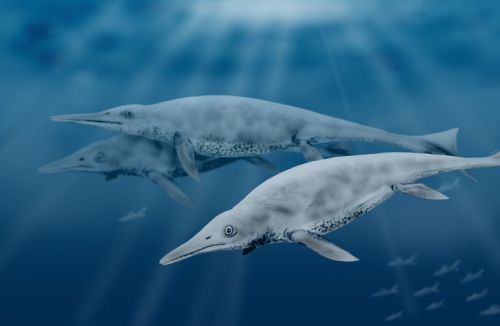 |
| Shastasaurus pacificus, an ichthyosaur from the Late Triassic of California and Mexico, illustration by Nobu Tamura (Wikipedia). Length of original animal about 7 meters. Based on related species, it is now considered that these animals had shorter snouts. Nevertheless, the above is very representative of the typical shastasaur type |
  |
| Forefin of Toretocnemus zitteli, from Merriam 1908 (left) and Shonisaurus popularis, from Camp 1980 (right) (both via Maisch & Matzke 2000). In contrast to both the earlier Ichthyosaur and later Thunnosaur conditions, the flipper is very long, with only three digits/fingers (both the thumb and little finger are lost). Californosaurus and Callawayia seem to have been very similar. In more advanced ichthyosaurs (Parvipelvia and Thunnosauria, additional digits are added, broadening the fin. |
Between the more primitive and elongate, serpentine-like basal ichthyosaurs of the early and middle Triassic, and the fully fish- and dolphin-like Jurassic and Cretaceous forms, are a number of intermediate types which in older books were classified as Shastasauridae, and which flourished during the later Triassic (specifically the Carnian and Norian ages). These represent an important and diverse assemblage that in the past have understandably been neglected in favour of the more famous and beautifully preserved Liassic (Early Jurassic) forms from England and Germany. But the discovery of many new Triassic forms, and cladistic analysis of both Triassic and Jurassic types, has created new interest in these earlier "fish lizards".
For the most part, these late Triassic (which all belong to the clade Merriamosauria) are intermediate in form between the sinuous and more typically reptilian early and middle Triassic species, and the fish and dolphin like latest Triassic (Rhaetian) and Jurassic and Cretaceous types. However, in contrast to their mixosaur ancestors (who had short broad fins), these late Triassic Merriamosaurs all had paddles of the elongate, "longipinnate" type (see right), usually with only three digits (fingers/toes) but each having a great many phalanges (finger/toe bones). For a long time this was used as a basis for classification ((e.g. Lydekker, 1888; von Huene 1922; McGowan 1972), and ichthyosaurs divided into latipinnate and longipinnate types, the former including Mixosaurs and most of what are now called Thunnasaurs (Stenopterygius, Ichthyosaurus, and the Ophthalmosaurs), and the latter the rest. It was thought therefore that the Triassic -Mixosaurs evolved into the broad-finned Jurassic types, and the Shatsasaurs (including Cymbospondylus) into the narrow-finned Jurassic genera. However, this classification is no longer used, and it has been shown that Mixosaurus is much closer to Cymbospondylus (both being basal forms), whilst latipinnate and longipinnate ichthyosaurs likewise are closely related. The latipinnate Ophthalmosaurs even include a longipinnate genus, Platypterygius
As the following dendrograms show however, there is some disagreement over whether the Shastasaurs and basal Euichthyosaurs constitute two main clades and lines of Triassic Merriamosaur evolution, or a single series of transitional forms. In any case, the Shastasaurs did not outlive the Triassic, whilst the the Euichthyosaurs evolved into (and cladistically include) the more "typical" Jurassic ichthyosaurs. Several alternative dendrograms are given below:
--+--Utatsusaurus `--+--Grippidia `--+--Cymbospondylus `--+--Mixosaurus `--o Shastasauria |--o Merriamosauria | |--Besanosaurus | `--+--Shastasaurus | `--Shonisaurus `-- o Euichthyosauria `--+--Californosaurus `--+-- Parvipelvia `-- Thunnosauria Motani 1999b (only selected genera shown) |
--+--Utatsusaurus `--+--Grippidia `--+--Cymbospondylus `--+--Mixosaurus `--+--Besanosaurus `--+--Shastasaurus `--+--Shonisaurus `--+--Californosaurus `--+--Callawayia (= Metashastasaurus) `--+--Parvipelvia `--Thunnosauria Maisch & Matzke 2000 (only selected genera shown) |
--+--Utatsusaurus `--+--+--Grippidia | `--+--Mixosaurus | `--+--Cymbospondylus | `--+--Besanosaurus | `--+--Shastasaurus | `--+--Shonisaurus | `-- Metashastasaurus (= Callawayia) `--Parvipelvia (advanced forms) Nicholls & Manabe, 2001 (only selected genera shown) found a monophyletic Shastasauridae, with Mixosaurus and Cymbospondylus as successive sister taxa to Besanosaurus + (Shastasaurus + (Shonisaurus + Metashastasaurus)). I don't have a copy of the original paper so I am not sure if Mixosaurus and Cymbospondylus are in the right position in the above cladogram. |
--+--Utatsusauridae `--+--Grippidia `--+--Cymbospondylidae `--+--Mixosauria `--+--Besanosauridae `--+--Shastasauria | |--Shastasaurus | `--Shonisaurus `--+--Californosauridae `--+--Parvipelvia `--Thunnosauria McGowan & Motani, 2003 - based on taxonomy in table of contents (here refernce is made to supra-generic taxa, but otherwise the arrangement is the same) |

The cladogram on the left is from Sander et al 2011 and reproduced under the Creative Commons Attribution License of the original paper. It represents the strict consensus (and hence most reliable but lowest resolution) of 72 most parsimonious trees. The three species of Shastasaurus are shown in bold. Note the paraphyletic nature of the Shastasauria. Interestingly, Californosaurus is here placed as more basal rather than crownward. The enigmatic Hupehsuchia here appear as stem ichthyopterygia. MAK111123 |
|
Regardless of which hypothesis is preferred, the shastasaurs, like their predecessors the Cymbospondyls attained very large size. In the case of the Shonisaurs they became much larger, and in advanced forms less sea-serpent like and more stocky and deep bodied then is the case with Cymbospondylus. Here we see an example of convergent or parallel evolution with the toothed whales of the Cenozoic oceans; although in the rapid evolutionary tendency to huge size there is a similarity with the baleen whales, which likewise grew from medium-sized to enormous creatures in the space of some five or ten-odd million years (Miocene-Pliocene). Reaching lengths of 10 to 23 meters, and with bodies that were quite deep and sturdy, the shonisaurs were not only the largest ichthyosaurs, but also among the largest of the marine animals of the Mesozoic. These giant ichthyosaurs, which were far larger than any of the contemporary Triassic land-living archosauromorphs and early dinosaurs, would have lived a lifestyle much like that of the present day toothed whales, feeding primarily on cephalopods. They were probably slow swimmers, rowing themselves slowly along with their long paddle-like limbs. MAK100925
Phylogentic definition: last common ancestor of Shastasaurus pacificus and Ichthyosaurus and all of its descendants ( Motani 1999b), amended by Maisch & Matzke 2000 to last common ancestor of Besanosaurus leptorhynchus and Ichthyosaurus communis and all of its descendants.
Phylogeny: Ichthyosauria :: Mixosaurus + *: Shastasauria + Euichthyosauria.
Range: Middle Triassic to Late Cretaceous. Mostly Late Triassic and Jurassic forms.
Characters: tooth implantation aulacodont except in Shonisaurus (Shastasauria), which has unique implantation like Cymbospondylus [M97]; tooth roots not expanded [M97]. ATW020516
Links: Eyes. ATW020516.
References: Motani (1997) [M97].
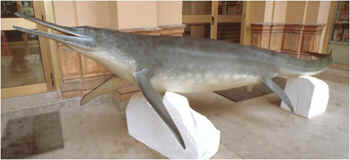 Shastasauria:
(= Shastasauridae) Besanosaurus, Himalayasaurus, Metashastasaurus,
Shastasaurus, Shonisaurus.
Shastasauria:
(= Shastasauridae) Besanosaurus, Himalayasaurus, Metashastasaurus,
Shastasaurus, Shonisaurus.
Range: Early? Triassic to Late Triassic of Japan, China and North America
Phylogeny: either Merriamosauria:
Euichthyosauria + * : Besanosaurus + (Shastasaurus + Shonisaurus) (monophyletic clade, according to Motani 1999b and Nicholls & Manabe, 2001)
or Merriamosauria : Besanosaurus + (Shastasaurus + (Californosauridae + Shonisaurus + (Callawayia + Parvipelvia))) (paraphyletic grade, according to Maisch & Matzke 2000)
Characters: medium to quite large in size; teeth isodont [S97]; implantation probably aulacodont in some species [Mo97]; $ parapophysis diminishes and disappears along cervical series [S97]; $ diapophysis elongates along cervical series [S97]; in Shonisaurus, diapophysis may split briefly into two dorsal & ventral, separate articulations over dorsal series [C80], [S97]; diapophysis separates from neural arch midway through dorsal series & moves down centra, becoming rounded instead of elongate [S97] (see also image at Californosaurus); no dorsal fin or semilunate caudal "fin"; less than 4 complete digits on fins [S97] [M97]; humerus very robust & usually as wide as long [M99]; humerus anterior flange reduced, thickened, and may be emarginated in the middle [M99]; humerus anterior flange tilted slightly dorsally [M99]; reduction of posterior humeral shaft proximally and distally [M99]; humerus with articular facet for radius enlarged, twice as wide as ulnar facet [M99]; deltopectoral ridge may run anterodistally or distally from deltopectoral crest, or posterodistally (plesiomorphic state) [M99]; humerus posterodistal tuberosity pronounced [M99]; humeral head may be directed proximodorsally (not proximally) &, if so, scapula glenoid facet tilted ventrally [M99]; movement still basically anguilliform.
Comments: An the basis of cladistic analysis, Motani 1999b shows the traditional family Shastasauridae are shown to be polyphyletic and paraphyletic, with Cymbospondylus representing a very primitive form (sister group to Mixosaurs and more derived ichthyosaurs) , while Californosaurus and Toretocnemus are not shastasaurs but euichthyosaurs. Maisch & Matzke 2000's cladistic analysis on the rejects the Shastasauria and considers Toretocnemus more basal than Cymbospondylus. Sander et al 2011's analysis makes the Shastasauria a paraphyletic grade. MAK100925
Links: Eyes; New Shastasaurid from Canada; Besanosaurus (Italian); modello del besanosauro; Paleontology and Geology Glossary: Be; EXN Science Wire: Daily news from the world of science; SVPCA 2000 -Abstracts L-M; NRC Research Press: Canadian Journal of Earth Sciences; Darren Naish. A new species of shastasaurus ...; Welcome to Prehistorics Illustrated; Dinosaurier-Interesse - Saurier- Ordnung der Ichthyosauria (German); DinoData Marine Reptiles Ichtyo; ON THE EVOLUTION AND HOMOLOGIES OF ICHTHYOPTERYGIAN FOREFINS; TERRITÓRIO DOS DINOSSAUROS (Portuguese: extensive discussion of Shonisaurus); Re- NEW RHYNCHOSAUR & TEMNOSPONDYLS (summarizes some new phylogenies); Scopriamo insieme.
References: Camp (1980) [C80], McGowan (1997) [M97]; Motani (1997) [Mo97]; Motani (1999) [M99]; Sander (1997) [S97]. ATW031003
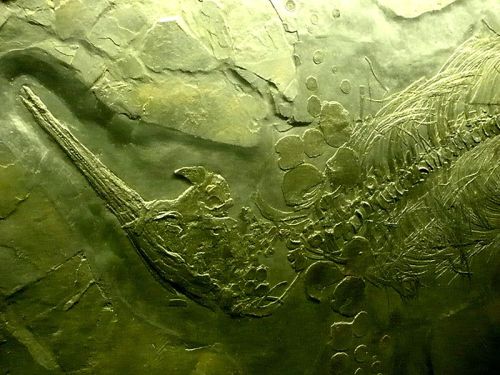 Fossil of Besanosaurus leptorhynchus, photo by Ghedoghedo, Wikipedia |
Besanosaurus: Besanosaurus leptorhynchus Dal Sasso & Pinna 1996
Range: Middle Triassic of Europe
Phylogeny: either Shastasauria : (Shastasaurus + Shonisaurus) + *: . (Motani 1999b and Nicholls & Manabe, 2001)
or Merriamosauria : (Shastasaurus + (Californosauridae + Shonisaurus + (Callawayia + Parvipelvia))) + * (Maisch & Matzke 2000)
Characters: teeth very small, isodontous (all of the same size and shape), snout very gracile and slender.
Comments: An unusually slim-snouted but large form, growing to 5 to 6 meters in length. Probably an eel-like swimmer. X-rays revealed the presence of embryos, indicating that these animals gave birth to live young. A smaller animal, Mikadocephalus, named in 1997 for a skull from Monte San Giorgio, may be related. Specimens attributed to the latter have also been reported from Spitsbergen (ref Darren Naish blog and Paleontology Newsletter no. 60 pp.81-2). Motani 1999b and Nicholls & Manabe, 2001 include Besanosaurus as a basal member of a monophyletic Shastasauria, whereas Maisch & Matzke 2000 consider Shastasauria a paraphyletic grade of intermediate ichthyosaurs
Links: Wikipedia
References: Maisch & Matzke 2000 p.68. MAK100923
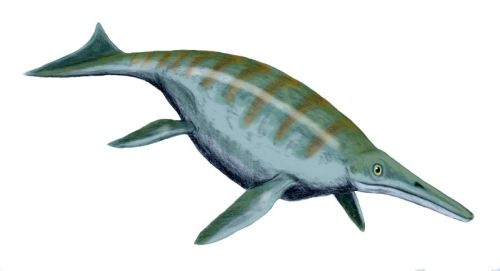 |
| Shonisaurus popularis from the Carnian of West Laurasia (but as an open ocean species probably of global distribution), illustration by Nobu Tamura (Wikipedia). Length of original animal 15 meters. |
Shonisaurus S. popularis Camp
Range: Carnian, known from the Luning Formation (Upper Carnian), of Nevada
Phylogeny: either Shastasauria : Besanosaurus + (Shastasaurus + * : Shonisaurus popularis + Shonisaurus sikanniensis) (Motani 1999b and Nicholls & Manabe, 2001)
or Merriamosauria : Besanosaurus + (Shastasaurus + (Californosauridae + (Callawayia + Parvipelvia) + * :Shonisaurus popularis + Shonisaurus sikanniensis)) (Maisch & Matzke 2000)
or Merriamosauria : (Parvipelvia + Shastasaurus) + * (Sander et al 2011)
Characters: Very large ichthyosaur, over 12 m, very long but robust snout, coronoid very large, fore- and hindfins essentially tridactyl. scapula rather long and slender with reduced anterior and posterior extensions, thoracal and caudal vertebral centra very high, thoracals more than three times as high as long.
Note: Study of Shastasaurus sikanniensis, along with re-examination of S. popularis, suggests that Shonisaurus was not as deep-bodied as previously reconstructed (Nicholls & Makoto 2004), an attempt at a more accurate recomnstruction here
Comments: Camp divided this genus into three species found at different stratigraphic levels, but later workers have synonymised these. It is not impossible even so that these could represent a single chronospecies which increased in size with time. In 1984, this species was adopted as the State Fossil of Nevada.
Links: Shonisaurus popularis - Oceans of Kansas; THE ICHTHYOSAUR Nevada's State Fossil.; Shonisaurus - Lost Creatures Project (with pencil drawing with better proportions then the usual over deep-bodied reconstructions), Wikipedia
References: Camp 1980, Maisch & Matzke 2000 p.69. MAK100923, 111123
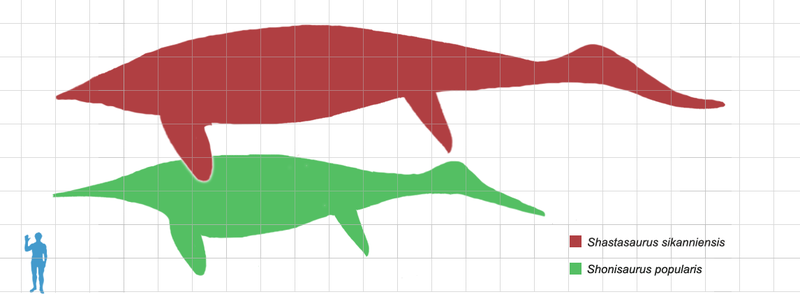 |
| A comparison of the body sizes between giant Shastasaurs and an adult male human. Shonisaurus popularis is shown in green, and Shastasaurus sikanniensis in red. Grid segment = 1m. Diagram by Matt Martyniuk & Dmitry Bogdanov, Wikipedia. |
Shastasaurus S. pacificus, S. liangae, S. sikanniensis
Phylogeny: either Shastasauria : Besanosaurus + (Shonisaurus + *) (Motani 1999b, Nicholls & Manabe, 2001)
or Merriamosauria : Besanosaurus + ((Californosauridae + Shonisaurus + (Callawayia + Parvipelvia)) + *) (Maisch & Matzke 2000)
or Merriamosauria : Shonisaurus + (Parvipelvia + * : S. sikkanniensis + (S. liangae + S. pacificus)) (Sander et al 2011)
Comments: Wikipedia: Shastasaurus' skull bore an unusually short, toothless snout compared to the long, toothed, dolphin-like snouts of most ichthyosaurs. It is likely that this strange snout indicates that Shastasaurus was a suction feeder, feeding primarily on soft-bodied cephalopods which lacked shells. In S. liangae, the only species with several well preserved skulls, the skull measures only 8.3% of the total body length (9.3% in a juvenile specimen). Unlike the related Shonisaurus, even juvenile Shastasaurus completely lacked teeth. The snout was highly compressed via a unique arrangement of skull bones. Unlike almost all other reptiles, the nasal bone, which usually forms the mid part of the skull, extended to the very tip of the snout, and all bones of the snout tapered to abrupt points.[3]
References: Sander et al 2011. MAK111123
 |
| Shastasaurus pacificus © University of California Museum of Paleontology - more photos |
Shastasaurus pacificus Merriam, 1895
Synonyms: Shastasaurus alexandrae Merriam, 1902; Shastasaurus osmonti Merriam, 1902
Phylogeny: Shastasaurus : S. sikkanniensis + (S. liangae + * )
Characters: Centra (see photo right) very short , humerus, radius, and ulna (arm bones) shortened
Comments: Until recently, the genus Shastasaurus and the family Shastasauridae have been hard to define due to the fragmentary nature of the type specimens. Shastasaurus pacificus Merriam, 1895 (type species) and Shastasaurus alexandrae Merriam, 1902 (both from the Carnian, Hosselkus Limestone Formation, Shasta County, California, although S. alexandrae is now considered a synonym of S. pacificus) are included in this genus, but Shastasaurus neoscapularis Shastasaurus neoscapularis from the slightly later Pardonet Formation of British Columbia is a much more advanced form, similar to Shonisaurus on the one hand, and more advanced Ichthyosaurs on the other, and is relocated to a separate genus (Callawayia = Metashastasaurus). Like most shastasaurs, these were large ichthyosaurs, the various species increasing in size from early to later, ranging from about 3 to 10 meters in length (von Zittel & Eastman, 1932 p.280). The average size of S. pacificus was about 3 1/2 to 4 1/2 meters in length, about the size of a large dolphin. Both fore and hind fins were long and narrow, perhaps with only three digits each (longipinnate) (Hilton, 2003 p.88)
References: von Zittel & Eastman, 1932, Maisch & Matzke 2000 pp.67-8. Hilton, 2003, MAK100925, 111123
Shastasaurus liangae (Yin et al., 2000)
Synonyms: Guanlingsaurus liangae Yin et al., 2000
Phylogeny: Shastasaurus : S. sikkanniensis + (S. pacificus + * )
Comments: Wikipedia: Shastasaurus liangae was the first species to definitively show the unusual short-snouted, toothless nature of Shastasaurus. It is known from several good specimens, and was originally placed in the separate genus Guanlingsaurus. The largest specimen (YIGMR SPCV03109) measures 8.3 metres (27 ft) long. A juvenile specimen (YIGMR SPCV03108) has also been found, measuring 3.74 metres in length. (Sander et al 2011)

Synonyms: Shonisaurus sikkanniensis Nicholls & Manabe, 2004
Range: Norian (known from the Pardonet Formation (Norian) of British Columbia,)
Phylogeny: Shastasaurus : (S. pacificus + S. liangae ) + *
Characters: Differs from Shonisaurus in having a fan-shaped scapula, and relatively longer vertebral centra.
Comments: The type specimen is considerably larger than Shonisaurus popularis, with an estimated length of 21 m. Teeth are known only in a few, small individuals, implying that they were present only in juveniles, and that adults were edentulous (toothless). This raises the question of what such big animals ate. It is likely that, as with most ichthyosaurs, these animals fed on belemnites (Mesozoic squid-like cephalopods), procuring larger volumes of food through suction feeding. "The large ceratobranchials of Shonisaurus imply powerfully developed gular muscles that control the tongue and floor of the mouth. This may have facilitated expansion of the gular region, creating a drop in intraorbital pressure, and allowing prey to be sucked in. A recent analogy would be the beaked whales (Family Ziphidae), which feed on squid, and are for the most part, edentulous. Beaked whales have throat grooves allowing for expansion of the gular region. Like Shonisaurus, they have large hyoid bones, larger than those in non-suction feeding dolphins." (Nicholls & Makoto 2004)
Update: Wikipedia: S. sikkanniensis was originally described in 2004 as a large species of Shonisaurus. However, this classification was not based on any phylogenetic analysis, and the authors also noted similarities with Shastasaurus. The first study testing its relationships, in 2011, supported the hypothesis that it was indeed more closely related to Shastasaurus than to Shonisaurus, and it was reclassified as Shastasaurus sikkanniensis. (Sander et al 2011)
References: Nicholls & Makoto 2004, Sander et al 2011 MAK100923, 111123
Euichthyosauria Motani 1999b
Range: Late Triassic to middle Cretaceous
Phylogeny: Merriamosauria: Shastasauria + *: Californosaurus + Parvipelvia. (Motani 1999b)
Comments: An the basis of cladistic analysis, Motani 1999b distinguishes the new taxon Euichthyosauria from the Shastasauria . The traditional Shastasauridae are shown to be polyphyletic, with Cymbospondylus representing a very primitive form (sister group to Mixosaurs and more derived ichthyosaurs) , while Californosaurus and Toretocnemus are not shastasaurs but euichthyosaurs. Maisch & Matzke 2000's cladistic analysis arrives at different results: Mixosaurus and Toretocnemus are more primitive than Cymbospondylus, and the disting\inction between Shastasauria and Euichthyosauria is rejected. MAK100925
Links: Phylogeny of the Ichthyopterygia. ATW020517.
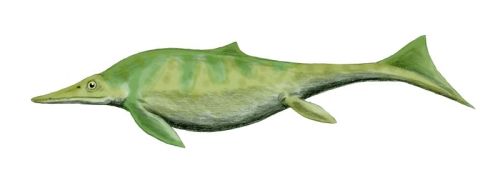 |
| Californosaurus perrini, an ichthyosaur from the Late Triassic of, naturally, California. Illustration by Nobu Tamura (Wikipedia). . |
Californosaurus C. perrini
Synonyms: Delphinosaurus, Perrinosaurus, Toretocnemus?
Range: Late Triassic of North America
Phylogeny: either Euichthyosauria: Parvipelvia
+ *. (Motani 1999b)
or Merriamosauria : Besanosaurus + (Shastasaurus + (Shonisaurus + (Callawayia + Parvipelvia) + *)) (Maisch & Matzke 2000)
Characters: ~3 m; somewhat elongated; 45-50 dorsal vertebrae, centra long, rib articulations as in shastasaurs [S97] (see also image); tail sharply down-turned, with possible semilunate caudal fin; phalanges circular & widely spaced, giving large, rounded flipper [C80].
Comments: The most basal of the euichthyosaurs is Californosaurus Kuhn, 1934. (Synonym: Delphinosaurus; Toretocnemus has been restored as a distinct genus ). Californosaurus is known from the Lower Hosselkus Limestone of California. Although it is a Triassic species, it has the "fishy" appearance and medium size (3 m) of many Jurassic forms. Californosaurus is distinguished by a smaller number of pre-sacral vertebrae (45 or 50) than is usual in ichthyosaurs, but each vertebra is somewhat elongate Camp (1980: 195), so it still has the normal body length. The tail (right) is sharply bent downwards, giving the animal a shark-like caudal (tail) fin; a characteristic of later ichthyosaurs. The phalanges (finger and toe bones) are quite circular and widely spaced, giving a more rounded flipper. The skull is not known.
Links: Paleontology and Geology Glossary: C; The Journal of Vertebrate Paleontology.
References: Camp (1980) [C80]; Sander (1997) [S97]. ATW020517.
Callawayia / Metashastasaurus:
Synonym: Shastasaurus neoscapularis
Range: Late Triassic (early Norian), Pardonet Formation of British Columbia
Phylogeny: Euichthyosauria ::: Parvipelvia + *. (Considered the sister taxon to Shonisaurus by Nicholls & Manabe 2001 who place it in a monphyletic Shastasauria)
Characters: length ~ 2 meters; post-cranially, resembles the shastasaurids, e.g. latipinnate (humerus short, forefin tridactyl), but differs from Shastasaurus in having a radically different scapula, like that of typical Jurassic taxa like Ichthyosaurus and Stenopterygius, and the shape of the scapula and fibula. The skull, with its large orbit, narrow postorbital region, small maxilla, and a parietal ridge and postparietal shelf is unlike Shastasaurus but similar to that of more advanced ichthyosaurs (McGowan, 1994; Nicholls & Manabe, 2001)
Comments: Previously named Shastasaurus neoscapularis but differs significantly from the type species, Shastasaurus pacificus, e.g. in morphology of the frontals, and therefore needs to be allocated a new genus. Named Metashastasaurus by Nicholls & Manabe 2001. Unfortunately, the same specioes was simultaneously being redescribed by Maisch & Matzke 2000 who allocated it to their new genus Callawayia. This occurred while Nicholls & Manabe, 2001 was in press, and was unknown to the latter authors. Metashastasaurus thus becomes a junior synonym of Callawayia. Nicholls and Manabe note (in an addendum) that Maisch knew that their work was in progress and thus the publication of the name Callawayia represents a breach of the ICZN Code of Ethics . (Darren Naish - Dinosaur Mailing List). The result (as well as disagreement over phylogeny constituting the so-called "ichthyosaur wars". I'm not sure of the current status of the name Metashastasaurus, although it has been used in preference to Callawayia in at least one paper - see Shang & Li 2009 MAK100925
| Page Back | Unit Home | Page Top | Page Next |
checked ATW031003. Current page MAK100925, revised MAK111123